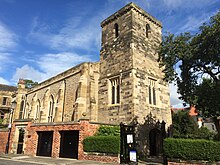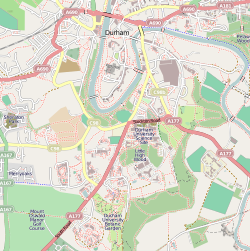St Cuthbert's Church, Durham
| St Cuthbert's Church, Durham | |
|---|---|
 |
|
| Coordinates: 54°46′29″N 1°34′11″W / 54.7746°N 1.5696°W | |
| Location | Durham |
| Country | United Kingdom |
| Denomination | Roman Catholic |
| Website | StCuthberts-Durham.org.uk |
| History | |
| Founded | 1827 |
| Dedication | St Cuthbert |
| Consecrated | 20 July 1910 |
| Architecture | |
| Status | Active |
| Functional status | Parish church |
| Heritage designation | Grade II listed |
| Designated | 10 March 1988 |
| Architect(s) | Ignatius Bonomi |
| Architectural type | Gothic Revival architecture |
| Style | English Gothic architecture, Perpendicular Gothic |
| Administration | |
| Deanery | St Cuthbert, Durham |
| Diocese | Hexham and Newcastle |
| Province | Liverpool |
St Cuthbert's Church is a Roman Catholic parish church in Durham, England. It was opened on 31 May 1827 to replace two previous chapels, one run by the secular clergy and the other by the Jesuits. It is also the home of the Durham University Catholic Chaplaincy and Catholic Society. From 2012 to 2016 the parish was entrusted, along with the chaplaincy, to the Dominican Order, and its congregation has since maintained the Dominicans' influence. The church is a protected building, being part of the Elvet Green Conservation Area. It is named for St Cuthbert of Lindisfarne, the 7th century bishop, healer and patron of Northern England.
Although the establishment of the church goes back to 1827, the building has served a community of Durham and Northumberland Catholics that is continuous from the beginning of Catholic persecution at the English Reformation. With the onset of the reformation promoted by Henry VIII, and later Elizabeth I, the North of England remained largely Roman Catholic. While the Church of England became the official and only public Church for many centuries, English Catholic communities remained in the North —St Cuthbert's was founded by such a Catholic community in Durham. In fact, Catholics have worshipped in the Old Elvet neighborhood going back to Anglo Saxon Durham. In 1569, Durham was the theatre for the Rising of the North. Promoted by the Catholic Percys and Nevilles, respectively the Earls of Northumberland and Westmoreland, Northern English nobles rose against Elizabeth I to bring the Catholic Church back to England in a rebellion that climaxed with the Catholic Mass revived and celebrated at Durham Cathedral. The following year, the priest who celebrated at this Mass, Thomas Plumtree, was drawn and quartered in the market place. Plumtree was beatified by Pope Leo XIII in 1886, and St Cuthbert's maintains relics of his arm and hand.
...
Wikipedia

